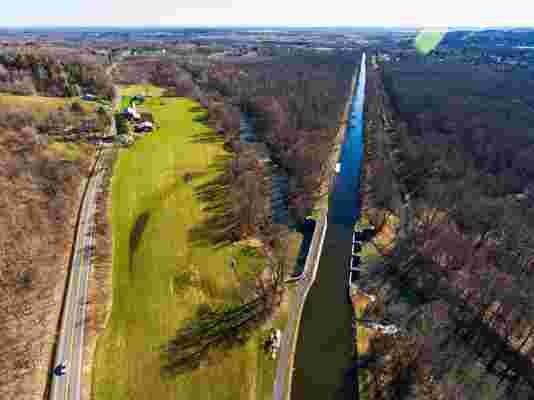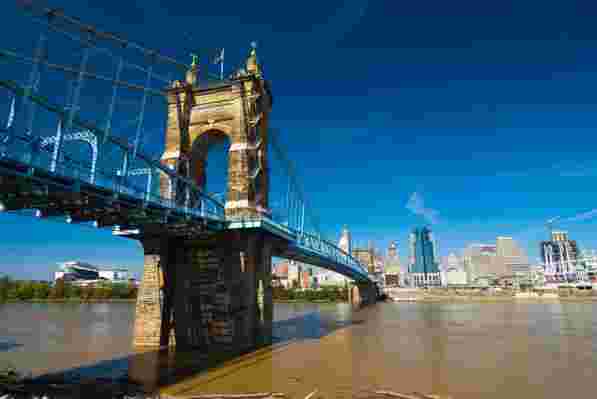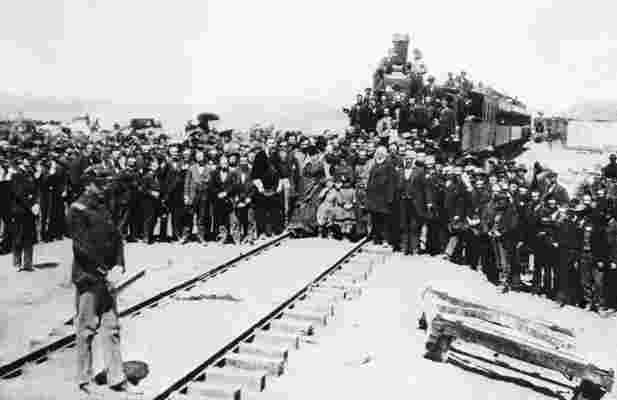November 20,2022
10 Modern Marvels That Changed America Forever
by David Stewart
Humans, by nature, are problem solvers, and during the U.S.’s brief history, some of the greatest engineering minds have dreamed up solutions that at one point seemed impossible. Over the last two centuries, these projects have contributed to the country’s infrastructure, and further changes are being made still today. In a new episode, the PBS series “10 That Changed America” tells the story of the engineering marvels that moved the country in a new direction—literally, with bridges, train tracks, and paved roads. While we might take some of these projects, like the Interstate Highway System, cross-country train routes, and even simple underwater tunnels, for granted these days, they were only possible through the genius and labor of thousands of men and women. Here, take a look at ten of the most impressive modern engineering feats in America, from the Transcontinental Railroad, which eliminated the dangerous wagon journey taken by brave westward explorers (or the extraordinarily lengthy boat ride through the Panama Canal), to the Holland Tunnel, which was the world’s first underwater tunnel for cars.
1. Erie Canal, New York

Connecting the Atlantic Ocean with the Great Lakes, the Erie Canal became an essential trade route that efficiently and affordably brought the goods from America’s heartland—like grain—to the more populous East Coast. When it was completed in 1825, the 363-mile canal was the second longest in the world.
2. John A. Roebling Suspension Bridge, Cincinnati

At first glance, you might think this bridge is New York’s iconic Brooklyn Bridge, but it’s actually the architect’s first creation: the Roebling Bridge linking Cincinnati and Covington, Kentucky. With a span of 1,057 feet, it was the longest suspension bridge in the world when it was built, only to be surpassed by the Brooklyn Bridge when it opened in 1883.
3. Transcontinental Railroad

Though thousands of miles of train tracks ran across the East Coast in mid-19th-century America, there was no transcontinental route. Thus, two railroad companies, the Central Pacific and the Union Pacific, were tasked to start building from Sacramento, California, and the Missouri River, respectively, then meet somewhere in the middle to join tracks. Mainly using Chinese laborers, the companies built their railroads in five years, connecting the two in Promontory, Utah, in 1869.
4. Eads Bridge, St. Louis
The first steel-truss bridge in the world was built in 1874, spanning the great Mississippi River, the divide between eastern and western America. The engineer, James Buchanan Eads, was entirely self-taught, but he had proved his skills by building ironclad ships during the Civil War. The strength of the bridge allowed trains to cross the river in St. Louis and proved that steel was the building material of the future.
5. Reversal of the Chicago River, Chicago
In the early days of the city, the Chicago River flowed into Lake Michigan, which initially wasn’t a problem—until the sewage and runoff from the rapidly growing metropolis began polluting the lake, which was used for drinking water. It was decided that the river’s flow would be reversed. Engineers dug the Chicago Sanitary and Ship Canal to drain the polluted water away from the city, using a series of locks to redirect the flow of water to the man-made river. The dirty water was directed toward St. Louis, a rival city.
6. Holland Tunnel, New York
One of the three tunnels that connect New Jersey to New York City, the Holland Tunnel was the world’s first underwater vehicular tunnel—a monumental engineering feat designed by architect Clifford Milburn Holland. Built over seven years and opened in 1927, the tunnel was also the first to use a mechanical ventilation system, designed by Ole Singstad, which prevented the deadly buildup of gases from the cars.
7. Hoover Dam, Nevada
It was decided that the Colorado River, the major source of water in the region, should be dammed to provide irrigation and hydroelectric power, as well as to prevent flooding. While it was being built between 1931 and 1936, the construction of the massive dam claimed over 100 lives. Today, in addition to providing resources to the American Southwest, it’s also one of the region’s most popular tourist attractions, drawing over one million visitors per year.
8. Colorado River Aqueduct, California
Southern California isn’t known for having great water resources, so when the population boomed in the early 20th century, a new source needed to be tapped. Engineers built the 242-mile Colorado River Aqueduct in 1930 to redirect water from the Colorado River. Water passes through open canals, tunnels, and even pump systems that bring it up and over the mountains.
9. Interstate Highway System (1956)
When President Dwight D. Eisenhower signed the Federal-Aid Highway Act of 1956, a new era of transcontinental connectivity was born. It took 35 years for the original 41,000-mile-long plan to be executed at a cost of $114 billion—well over the $26 billion budget. Today the Interstates remain largely the same, though a few tweaks have elongated the system to more than 46,000 miles.
10. New Orleans Hurricane & Storm Damage Risk Reduction System, New Orleans (2005)
When Hurricane Katrina leveled New Orleans in 2005, massive engineering changes were made to protect the city. Spearheaded by the U.S. Army Corps of Engineers, the project saw the construction of a two-mile, a 26-foot-high barrier, and a revamped canal system, as well as the addition of new pump stations.
RELATED: 10 Monuments and Memorials That Changed America Forever






